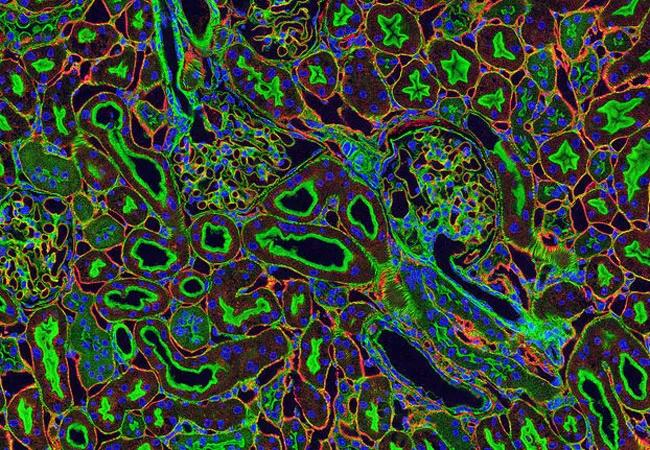Results of two studies presented at 2019 ASCO GU

Investigators from Cleveland Clinic Cancer Center and their collaborators presented data from two trials of treatments advanced and refractory renal cell carcinoma (RCC) at the 2019 American Society of Clinical Oncology (ASCO) Genitourinary (GU) Cancers Symposium. These studies add more potential paths to improved survival to the rapidly evolving landscape of RCC treatment.
Advertisement
Cleveland Clinic is a non-profit academic medical center. Advertising on our site helps support our mission. We do not endorse non-Cleveland Clinic products or services. Policy
Tivozanib is a highly selective vascular endothelial growth factor (VEGF) receptor tyrosine kinase inhibitor (TKI) currently under investigation in RCC. The phase 3 randomized, controlled, multicenter, open-label TIVO-3 trial aimed to compare the safety and efficacy of tivozanib with that of sorafenib, another VEGF TKI, in patients with mRCC who have failed two or three prior treatments. Dr. Rini and his colleagues planned TIVO-3 as a follow-up to TIVO-1, which showed greater progression-free survival (PFS) in patients with mRCC treated with tivozanib compared with those treated with sorafenib (11.9 months vs. 9.1 months, P=0.042), but better overall survival (OS) in patients treated with sorafenib.
“The main goal of TIVO-3 was to confirm the PFS results obtained in TIVO-1 in a cohort of patients who had failed at least two to three prior RCC treatments,” says Brian Rini, MD, Leader of Cleveland Clinic’s Genitourinary Cancers Program and lead author of both studies.
Three hundred and fifty subjects with mRCC were stratified into three groups according to International Metastatic Renal Cell Carcinoma Database Consortium (IMDC) risk category and type of prior therapy: 1) two TKIs, 2) TKI plus one checkpoint inhibitor and 3) TKI plus other treatment. Enrolled subjects were then randomized 1:1 to receive either tivozanib or sorafenib. The primary endpoint of the trial was PFS by blinded, independent radiological review. Secondary endpoints included objective response rate (ORR), OS, safety and duration of response.
Advertisement
“Patients treated with tivozanib demonstrated a significantly better median PFS [5.6 months] compared with patients treated with sorafenib [3.9 months], as well as a lower rate of grade 3 treatment-related adverse events [44 versus 55 percent),” says Dr. Rini. “In addition, the rates of drug discontinuation, dose reduction and dose interruption were all lower in patients treated with tivozanib.”
According to Dr. Rini, these findings underscore the utility of tivozanib monotherapy in patients with mRCC who have failed treatment with several other commonly used agents and who are left with limited treatment options.
PT2385 is a first-in-class inhibitor of HIF-2a, a transcription factor with established oncogenic activity. In a prior phase 1 dose escalation/expansion trial, PT2385 monotherapy was associated with varying degree of therapeutic exposure with higher doses demonstrating improved therapeutic efficacy.
In their second study, Dr. Rini and colleagues aimed to assess the safety and efficacy of PT2385 (800 mg twice-daily given perorally) in combination with nivolumab (3 mg/kg IV given once every two weeks) in an expansion cohort of pretreated patients with advanced clear cell renal cell carcinoma (ccRCC).
“This phase 1 trial is a part of the greater effort of demonstrating the safety and efficacy of combinations of targeted agents and immunotherapy agents in patients with advanced ccRCC,” explains Dr. Rini, adding that another immunotherapy agent, pembrolizumab, is currently under consideration for FDA approval for use in advanced ccRCC in combination with axitinib and will likely become the new standard of care for advanced ccRCC.
Advertisement
Fifty patients, with a median age of 62 years, were enrolled in the trial. The majority of study subjects received one prior therapy and 42 percent received ³ two prior therapies; all patients were pretreated with at least one VEGF receptor-targeting agent. The safety, efficacy and pharmacokinetics of administered treatment were evaluated during follow-up visits.
Fatigue (46 percent), anemia (46 percent), nausea (36 percent) and arthralgia (30 percent) were the most common all-grade adverse events (AEs); only two grade 4 AEs were observed and included increased levels of lipase/amylase and ALT. Median PFS was significantly shorter in patients with subtherapeutic exposures of PT2385 (4.7 m) compared with patients with therapeutic exposures (10.0 m). ORR was 22 percent.
“This combination treatment demonstrated an acceptable safety profile and improved PFS,” says Dr. Rini. “Our findings point to a promising anti-tumor activity of PT2385 in combination with nivolumab in patients with advanced ccRCC.”
“These studies bring us a step closer to building a more effective armamentarium of treatment options for patients with advanced RCC,” adds Dr. Rini.
Image: Stained kidney tissue. Credit: Tom Deerinck and Mark Ellisman, National Center for Microscopy and Imaging Research. From NIH Image Gallery. Licensed, no changes were made.
Advertisement
Advertisement

Study shows significantly reduced risk of mortality and disease complications in patients receiving GLP-1 agonists

Structured interventions enhance sleep, safety and caregiver resiliency in high-acuity units

Addressing rare disease and challenging treatment course in an active young patient

Large retrospective study suggests DOACs are safe, effective alternative to low-molecular-weight heparin in complex patient population

Study shows high rate of hematologic responses, low rate of disease progression

Bispecific antibody bridging therapy deepens durability of BCMA CAR T-cell therapy without overlapping toxicities in patients with relapsed/refractory multiple myeloma

Phase 2 study brings pivotal advances in treatment efficacy and safety for the most challenging-to-treat population

Patient with quadruple refractory multiple myeloma achieves complete response with cell therapy